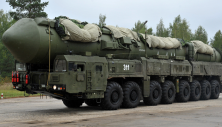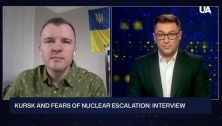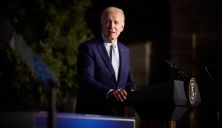By Niranjan Chandrashekhar Oak China is expanding and modernising its nuclear arsenal at an unprecedented speed. China’s development of newer...
Vous n'êtes pas connecté
- English
- Français
- عربي
- Español
- Deutsch
- Português
- русский язык
- Català
- Italiano
- Nederlands, Vlaams
- Norsk
- فارسی
- বাংলা
- اردو
- Azərbaycan dili
- Bahasa Indonesia
- Հայերեն
- Ελληνικά
- Bosanski jezik
- українська мова
- Íslenska
- Türkmen, Түркмен
- Türkçe
- Shqip
- Eesti keel
- magyar
- Қазақ тілі
- Kalaallisut ; kalaallit oqaasii
- Lietuvių kalba
- Latviešu valoda
- македонски јазик
- Монгол
- Bahasa Melayu ; بهاس ملايو
- ဗမာစာ
- Slovenščina
- тоҷикӣ ; toğikī ; تاجیکی
- ไทย
- O'zbek ; Ўзбек ; أۇزبېك
- Tiếng Việt
- ភាសាខ្មែរ
- རྫོང་ཁ
- Soomaaliga ; af Soomaali
Rubriques :
 Maroc - EURASIAREVIEW.COM - A la une - 04/Sep 23:43
Maroc - EURASIAREVIEW.COM - A la une - 04/Sep 23:43
Russia’s Nuclear Weapons – Analysis
By Anya L. Fink Russia presents an “acute threat” to the United States andits allies, according to the 2022 National Defense Strategy. The 2022 Nuclear Posture Review, a Biden Administration review of U.S. nuclear policy, states: "Russia remains the U.S. rival with the most capable and diverse nuclear forces. Today it is unique in the combination of strategic and non-strategic nuclear forces it fields that enables nuclear employment ranging from large-scale attacks on the [U.S.] homeland to limited strikes in support of a regional military campaign [in the Euro-Atlantic region]." Since Russia’s February 2022invasion of Ukraine, Russian President Vladimir Putin has threatened to use nuclear weapons against the West, stated that Russia has deployed nonstrategic nuclear weapons to its ally Belarus, and declared the suspension of certain Russian obligations under the New START Treaty that limit U.S. and Russian strategic nuclear forces. Congress may choose to examine U.S. deterrence and risk reduction policy toward Russia. Force Structure According to a recent nongovernmental estimate, Russia has around 1,710 deployed nuclear warheads based on a triad of strategic delivery vehicles roughly consisting of 326 intercontinental ballistic missiles (ICBMs), 12 ballistic-missile submarines (SSBNs) with 192 submarine-launched ballistic missiles (SLBMs), and 58 strategic bombers. Russia has not exchanged official data with the United States about the structure of its strategic nuclear forces since 2023. Russian officials have stated, however, that Russia continues to abide by New START limits, thus maintaining rough parity with U.S. strategic nuclear forces. According to one nongovernmental estimate, the United States has around 1,770 deployed nuclear warheads. Russia is concluding a modernization of its strategic nuclear forces that focuses in particular on the development of the SS-X-29 (Sarmat) heavy ICBM, the SS-27 Mod 2 (Yars) ICBM, and the Dolgorukiy (Borei) class SSBN, according to a 2024 Defense Intelligence Agency (DIA) assessment. Russia deploys the majority of its strategic nuclear warheads on ICBMs. A separate Russian military service, the Strategic Rocket Forces, commands these silo-based and mobile ICBMs. Russia can field most of its ICBMs and all of its SLBMs with multiple warheads on each missile, according to a nongovernmental source. Russia also has a variety of dual-capable systems (which are able to use conventional or nuclear warheads), including precision strike missiles, of various ranges and modes of launch, that are not limited by any arms control agreements. The Russian military could deploy these systems with nuclear warheads, enabling their use as nonstrategic nuclear weapons. Russia has rejected U.S. efforts to negotiate limits on Russian nonstrategic nuclear weapons, describing these weapons as an offset to U.S. and NATO conventional superiority. The State Department estimated in 2024 that the Russian military has between 1,000 to 2,000 nuclear warheads for nonstrategic weapons; nongovernmental organizations attribute 1,558 warheads to these systems. Russian officials have expressed concerns about the survivability of Russian strategic nuclear forces, given advances in U.S. long-range conventional strike and missile defenses. In 2018, President Putin announced that Russia was developing new delivery vehicles, including an ICBM- mounted hypersonic glide vehicle, a nuclear-powered cruise missile, and a nuclear-capable autonomous underwater system. According to 2024 testimony of NORTHCOM Commander General Gregory Guillot, “Russia intends for these systems to challenge U.S. defenses and guaranteeRussia’s ability to retaliate after a first strike.” Doctrine and Employment Plans According to a 2020 Russian doctrinal document, Russian nuclear deterrence policy seeks to maintain nuclear forces at a“sufficient”level,“guaranteesprotection of nationalsovereignty and territorial integrity,” deters aggression, andenables escalation management, as well as the“termination” of adversary “military actions” on conditions “acceptable” to Russia.The document adds that the Russian President could authorize nuclear weapons employment in scenarios that include“thearrival of reliable data” about aballistic missile attack against Russian or allied territory, the use by an adversary of“nuclear and other weapons ofmass destruction”against Russia or an ally, “adversary actions” on “government or military”targets that could affectRussia’s ability toretaliate with nuclear weapons, and conventional“aggression against[Russia]...when the very existence of thestate is in jeopardy.” Russian political and military leaders have articulated a“strategic deterrence” concept that combines nonmilitary means, nonnuclear capabilities, and nuclear weapons into a spectrum of continuous actions aimed at deterrence, escalation management, and warfighting. According to theU.S. intelligence community’s2024 Annual Threat Assessment (ATA),“Russia is expanding and modernizing”its dual-capable systems “because Moscow believes [they]offer options to deter adversaries, control the escalation of potential hostilities, and counter U.S. and Alliedconventional forces.”Western studies of authoritative Russian military writings depict several different variants of“ladders”involving steps with dual-capable systems the Russian military could take to deter or manage escalation. The Russian military plans for the use of military force through a system of“strategic operations.”According to nongovernmental sources, some of these operations may foresee large-scale as well as limited use of nuclear weapons. Other strategic operations may provide Russia with flexible coercive options below the nuclear threshold. According toGeneral Guillot’s2024 testimony, Russia could employ nonnuclear precision missiles and cybercapabilities “to strike Western economic and militaryinfrastructure in an attempt to degrade our political will andcompel negotiations to terminate an escalating conflict.” Russian Coercive Signaling Since 2022 Since February 2022, President Putin hasinvoked Russia’snuclear weapons in an apparent attempt to deter Western military intervention against Russia in Ukraine. According to the 2024 ATA, “Russia almost certainly does not want a direct military conflict with U.S. and NATO forces.”Russian nuclear signaling also has included announcements of increased nuclear readiness, exercises, and missile tests. Some experts in Russia have called for limited nuclear strikes and changes to doctrine, arguing that Russian nuclear threats have not deterred Western military aid to Ukraine. According to a 2024 DIA assessment, Following a period of heightened nuclear rhetoric from senior Russian leaders in late-2022, Putin has downplayed the possibility of a nuclear conflict in subsequent speeches and noted he saw no need tochange Russia’s nucleardoctrine. Belarusian President Alexander Lukashenko stated in April2024 that Russia deployed “several dozen” nuclearweapons to Belarus. Media reports suggest that Russia stationed nuclear-capable SS-26 (Iskander) short-range ballistic missiles to Belarus and trained Belarusian pilots on aircraft certified for carrying nuclear weapons. The DIA assessed in 2024 that Russia has“expanded its nonstrategic nuclear weapons posture”in Belarus. The DIA report further statedthat “Putin claims warheads were delivered toBelarus in June”2023, but positedthat “the new locationdoes not extend the range of Russia’s ability to deploynonstrategic nuclear weapons.” Russia may continue its nuclear signaling to the West as the war in Ukraine progresses. In May 2024, Russian officials announced exercises involving nonstrategic nuclear weapons, highlighting separate statements by French and U.K. leaders about, respectively, the possibility of Western troops in Ukraine and the use of Western systems in Ukrainian strikes on targets in Russia. During the summer of 2024, Putin stated that Russia is considering a response to potential evolution in U.S. and NATO deterrence postures as well as changes to Russia’snuclear doctrine. Russia also may choose to signal to the West through threats or demonstrations of nuclear testing. President Putin noted the possibility of nuclear tests in February 2023, and Russia withdrew its ratification of the Comprehensive Test Ban Treaty (CTBT) in November 2023. Russia maintains a nuclear testing capability at a test site in the Arctic. President Biden has raised concerns that President Putin may use nuclear weapons. In addition, the 2024 ATA states, “Russia’s inability to achieve quick and decisive battlefieldwins, coupled with Ukrainian strikes within Russia, continues to drive concerns that Putin might use nuclearweapons.”The 2024 DIA assessment also notes that“anexistential threat to the Russian state is cited in Russian doctrine...as justification for nuclear use, and the West cannot completely discount the possibility of Russia usingnuclear weapons in Ukraine.” The war in Ukraine may have implications forRussia’sthinking about the role of nuclear weapons. The attrition of Russia’s ground forcesduring the war in Ukraine raises theprospect that “Moscow will be more reliant on nuclear and counterspace capabilities for its strategic deterrence,”according to the 2024 ATA. In 2024, U.S. officials also expressed concern about Russia’splans to launch a nuclear- armed satellite into space. Arms Control and Strategic Stability In February 2023, President Putin announced that Russia would suspend its participation in the 2010 New START Treaty, an arms control agreement that limits U.S. and Russian strategic nuclear delivery vehicles to 800 and warheads actively deployed on these delivery vehicles to 1,550 each. Russian officials have said Russia would maintain treaty limits but discontinue on-site inspections and data exchanges. (See CRS Report RL33865,Arms Control and Nonproliferation: A Catalog of Treaties and Agreements.) In a 2024 report to Congress, the State Department stated that,while the United States “cannot certify” that Russia is compliant with New START,the department“does not determine”at present that“Russia’snoncompliance” “threatens national security interests.” As a result of Russia’s war in Ukraine, the United Statesand Russia have not met in a Strategic Stability Dialogue aimed at discussing future arms control since January 2022. Biden Administration officials have said since 2023 that the United States is willing to return to talks with Russia“without preconditions.” However, President Putin stated inFebruary 2024 that Russia would not discuss arms controlwhile the United States seeks to inflict “strategic defeat” onRussia by providing military aid to Ukraine. President Putin may choose to completely withdraw from New START or build up Russian nuclear forces after New START expires in February 2026. One nongovernmental estimate suggests that Russia holds 1,112 strategic nuclear warheads in reserve. Russia could mount some of these warheads onto its ICBMs or SLBMs. The United States holds 1,938 warheads in reserve, according to a nongovernmental estimate. The Congressional Commission on the U.S. Strategic Posture proposed in its 2023 reportthat the United States “prepare to upload some or all” of itsreserve warheads in response to the emerging“two-nuclear-peer” threat from Russia and China. Congress may consider some of the commission’s other recommendationsfor U.S. nuclear and conventional deterrence capabilities, cooperation with allies, and risk reduction with adversaries. (See CRS In Focus IF12621,Congressional Commission on the U.S. Strategic Posture.) About the author: Anya L. Fink, Analyst in U.S. Defense Policy Source: This article was published by the Congressional Research Service (CRS)
Articles similaires
ISW analyzes CIA chief’s statements regarding Moscow’s threats to use nuclear weapons
Experts from the Institute for the Study of War (ISW) analyzed the statements by Central Intelligence Agency Director (CIA) William Burns regarding...
ISW analyzes CIA chief’s statements regarding Moscow’s threats to use nuclear weapons
Experts from the Institute for the Study of War (ISW) analyzed the statements by Central Intelligence Agency Director (CIA) William Burns regarding...
Kursk and fears of nuclear escalation. Interview with Jake Broe
What is the impact of Kursk operation? Is there any risk of nuclear escalation? Why hasn't Putin been defeated yet? Why aren't there more weapons...
Russia Threatens to Change Nuclear Policy Over West's Role in Ukraine
Deputy Foreign Minister Sergei Ryabkov said Sunday that Russia would revise its nuclear weapons policy in response to what he sees as a Western...
Russia Threatens to Change Nuclear Policy Over West's Role in Ukraine
Deputy Foreign Minister Sergei Ryabkov said Sunday that Russia would revise its nuclear weapons policy in response to what he sees as a Western...
US Announces Over $700 Million New Aid To Ukraine
By Nike Ching The United States announced more than $700 million in new aid to Ukraine, including support for the country's energy sector, as...
Kyiv Regime Shuffles Cabinet Like Deckchairs On The Titanic – OpEd
Dozens of ministers and senior officials in the NATO-backed Kyiv regime have tendered their resignations ahead of a chaotic reshuffle. The political...
Kyiv Regime Shuffles Cabinet Like Deckchairs On The Titanic – OpEd
Dozens of ministers and senior officials in the NATO-backed Kyiv regime have tendered their resignations ahead of a chaotic reshuffle. The political...
US President Joe Biden stated that the issue of lifting the ban on Ukraine’s use of long-range weapons is currently under consideration
U.S. President Joe Biden stated on Tuesday that the issue of lifting the ban on Ukraine's use of long-range weapons is under review. When asked...
Les derniers communiqués
-
Adobe Brings Conversational AI to Trillions of PDFs with the New AI Assistant in Reader and Acrobat
Adobe - 21/02/2024
-
Laura Frigenti takes the Helm as Chief Executive Officer of the Global Partnership for Education
Global Partnership for Education - 05/12/2022


